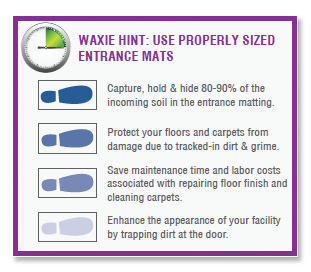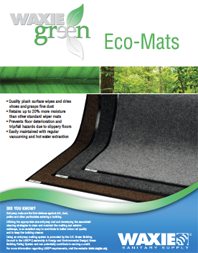Controlling dirt and debris will help maintain the look of floors
By Corinne Zudonyi, Editor, Trade Press Media - Housekeeping Solutions magazine and CleanLink.com
 Matting programs are the first step to achieving and maintaining a desired look of flooring, reducing frequency of stripping and finishing and saving on labor.
Matting programs are the first step to achieving and maintaining a desired look of flooring, reducing frequency of stripping and finishing and saving on labor.
According to industry experts, mats that are properly placed and cared for will reduce the amount of outdoor contaminants that are tracked into a facility. That being said, every facility should have matting systems at every entrance and exit.
"Matting is the first line of defense for any floor maintenance program. Its purpose is to stop soil before it comes into contact with the floor," says Stan Hulin, industry consultant and president and CEO of Future Floor Technology Inc., in Gladstone, Ore.
According to industry experts, the average person will track more than one pound of dirt into a facility every week on their shoes. As this dirt is carried throughout the facility, it can grind into increasingly dull floor finishes and absorb into carpets, causing additional work for the custodial crew.
ISSA has reported that custodial departments will spend at least $600 a week in labor hours to remove just one pound of dirt. And Don Aslet, founder of Varsity Facility Services in Pocatello, Idaho, comments that proper matting alone can save approximately 200 labor hours per year.
"Facilities must have a great walk-off matting program that absorbs soil before it enters the building," Hulin adds. "Laying 25 feet of matting can effectively remove 95 percent or more of soil before damage can be done."
In order to achieve the best results from matting systems, it is important to address placement. Experts recommend stretching matting at least 10 to 15 feet into the facility, which will allow the average person to step up to four times on each foot before walking off, collecting as much material as possible. Mats should also span at least the width of the door to guarantee effectiveness.
 "Proper matting is the number one way to keep dirt off floors," says Larry Johnson, product manager for S. Freedman & Sons Inc., Landover Md. "Neglecting your matting is one thing you can not afford to do."
"Proper matting is the number one way to keep dirt off floors," says Larry Johnson, product manager for S. Freedman & Sons Inc., Landover Md. "Neglecting your matting is one thing you can not afford to do."
Even if departments take advantage of a matting rental programs — where for a regular fee, the mats are serviced by an outside entity — proper interim care is essential. Experts recommend vacuuming mats at least once a day and shaking them weekly to eliminate dust and debris between laundering. Pressure washing and extraction cleaning of mats on a regular basis is also a good practice. High-traffic areas might benefit from more frequent maintenance.
As important as it is to care for mats, it is equally important to care for the floors they cover. Mats do absorb large amounts of debris, but fine dirt particles can make their way through the mat onto the floors underneath, scratching and damaging the surfaces. Vacuuming mats will minimize the amount of particles that reach floors, but departments should also clear excess debris regularly.
When properly cared for, mats are effective at grabbing dirt and debris before it enters the facility, but they are not a have-all-end-all solution to maintaining beautiful floors.
"If you have an excellent daily maintenance program in place, you can achieve consistently beautiful results," says Sortino.
Source: CleanLink

